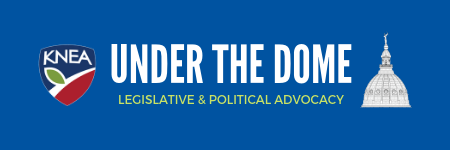
The at-risk post-audit report was presented in both the House Education Committee and the House K-12 Education Budget Committee today, filling the whole afternoon with two essentially identical presentations.
First to present was Heidi Zimmerman, the lead auditor on the report which is one of several required over the next few years as part of the school finance plan.
Zimmerman hedged her comments by saying that they were simply looking at whether or not spending was congruent with the statutes but the report has been met with frustration by those in the education community including the members of the State Board of Education and the State Department staff charged with overseeing the program.
The report is highly negative and essentially charges districts with spending at-risk money on students who are not identified as at-risk, implementing programs that are not evidence-based or research-proven, and spending on items that have absolutely nothing to do with at-risk programs. As for the State Department, they are charged with inadequate oversight.
But frankly, if one reads the report, one comes away convinced that it was written by people who neither understand at-risk students or how education functions in the 21st century.
Auditors interpret the statutes as requiring the State Department to publish a list of approved evidence-based programs from which districts would choose what to use – kind of like filling your at-risk shopping cart with products approved by someone who doesn’t understand what you need. In reality, the State Department maintains a website of resources for districts to examine as they put a program together. The local school district writes their own at-risk plan based on local needs and includes that as part of their consolidated plan required under the federal Every Student Succeeds Act (ESSA). The State Department reviews the consolidated plan, provides feedback, and ultimately approves the plan provided the district meets the evidence-based criteria.
It was noted that if the Department worked the way the Post Audit expected them to, then no school district could have used at-risk funds to pay for the JAG program – a program that has been lauded by legislators across the political spectrum – because that program was not on the website until this year.
The report also is critical of the fact that students who are not identified as at-risk might be benefiting from at-risk money. A theme of the presentations today hinted at the segregation of at-risk students from their non-at-risk peers in order to make sure that these targeted funds only served to meet the needs of identified students. This, of course, flies in the face of years of movement to include all students in the general education classroom and meet their needs through strategies liked tiered learning and differentiated instruction. As Brad Neuenswander of the KSDE pointed out that “at-risk students are also general education students” and that “all students benefit from best practices.”
It also needs to be noted that in the 20 school districts examined, the state provided $125 million in at-risk funding but those districts spent $161 million on at-risk programs and students. Auditors then identified $190,000 in “questionable” expenditures. We fail to see the scandal here. The state underfunded programs for at-risk students in these 20 districts by $36 million and then criticized the schools for spending $190,000 on items the auditors- not educators- thought would not help at-risk kids.


